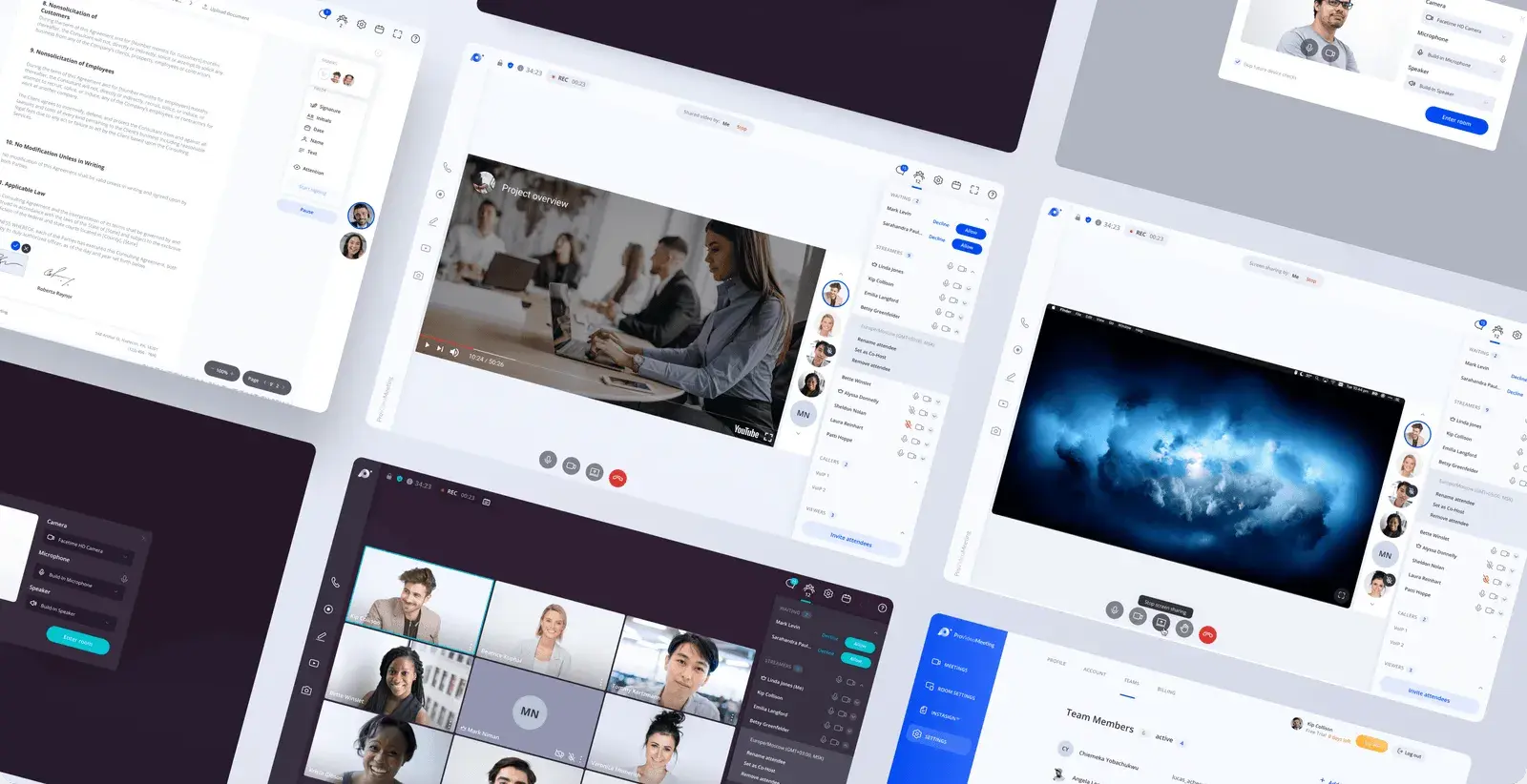
Finding the right WebRTC development company can make a big difference in your project's success. The best companies bring together technical skills, real experience with video conferencing apps, and a solid grasp of WebRTC basics like signaling and STUN/TURN servers. While many companies claim to offer WebRTC services, picking the perfect match involves looking at their past work, talking to their previous clients, and understanding how they handle costs. A good partnership starts with clear goals and open communication. This guide will help you spot the difference between companies that just talk big and those that actually deliver great WebRTC solutions.
Why Trust Our WebRTC Development Insights?
At Fora Soft, we've been at the forefront of multimedia development for over 19 years, specializing in video streaming solutions and real-time communication technologies. Our expertise in WebRTC isn't just theoretical - we've successfully implemented this technology across numerous projects, maintaining a 100% project success rating on Upwork. This perfect score reflects our deep understanding of WebRTC's capabilities and limitations in real-world applications.
Our team has hands-on experience with various WebRTC servers and frameworks, enabling us to provide informed insights on selecting the right technology stack for specific use cases. We've developed solutions across multiple platforms, from web applications to mobile devices and smart TVs, giving us a comprehensive understanding of WebRTC's performance across different environments. This practical experience has been crucial in helping us identify and overcome common challenges in WebRTC implementation, from scaling issues to security concerns.
⚙️Here’s more about our WebRTC Development Services
What's Technically Possible With WebRTC Right Now

WebRTC drives real-world applications like video conferencing and live streaming. It even connects IoT devices for remote control.
However, you should know about its current technical limits.
Real-World Applications: Video Conferencing, Live Streaming, and IoT Integration
While you might think of WebRTC as just a tool for video calls, it's doing a lot more under the hood. WebRTC powers video conferencing apps like Jitsi. These apps let users join meetings with a link. They don't need to download any software. Studies show that when WebRTC applications integrate machine learning to optimize video quality, user satisfaction rates exceed 85% in controlled environments (Ammar et al., 2019).
WebRTC also supports live video streaming. Users can broadcast events in real-time. Viewers watch from their browsers. No plugins needed.
Furthermore, WebRTC integrates with IoT devices. This means you can control devices remotely. For instance, you can check your home security camera. You just need an internet connection.
WebRTC keeps data private. It uses encrypted connections. This makes it secure for all these uses.
Our Experience: Building ProVideoMeeting - An Enterprise-Grade WebRTC Solution

In developing ProVideoMeeting, we faced the challenge of creating a robust video conferencing platform that would stand out in a competitive market. Our solution was to focus on legal compliance and security, implementing features like legal digital signatures with 12-AES encryption and identity verification through snapshots or SMS. The platform demonstrates WebRTC's capabilities in handling multiple concurrent users while maintaining HD quality on stable connections.
Our development process revealed that WebRTC's versatility extends beyond basic video conferencing. We implemented features such as vanity rooms for persistent meetings and advanced participant roles, demonstrating how WebRTC can be tailored to meet specific business needs. The success of this project, as evidenced by client feedback, shows the potential of WebRTC in creating enterprise-level solutions.
⚙️Here’s more about our WebRTC Development Services
Current Technical Limitations You Should Know About
You've seen what WebRTC can do—powering video conferences, live streams, and IoT device control. However, you should know its current limits. WebRTC works best with low-latency networks. Research shows that under real network conditions, latency significantly impacts the quality of WebRTC streams, leading to degraded user experience (Jansen et al., 2018). It struggles with high packet loss. This can affect video quality during meetings.
A skilled WebRTC developer can help, but can't solve every issue. Remember, is WebRTC peer-to-peer? Yes, but it needs servers for complex tasks. These servers handle things like relaying media when peers can't connect directly. They also manage signaling, the process of exchanging information to start a call.
Moreover, WebRTC doesn't support all video codecs. It primarily uses VP8 and H.264. This might limit compatibility with specific systems. Understanding these facts helps you set realistic expectations.
When developing ProVideoMeeting, we implemented automatic quality adjustment to address common WebRTC challenges with network stability. This approach helps maintain call quality even when network conditions aren't ideal.
Best WebRTC Development Companies and What Makes Them Stand Out
When you're looking for the best WebRTC development companies, start by checking their technical expertise and past projects.
You can better understand their pricing models by requesting quotes for specific projects.
Be cautious and look out for red flags like poor communication or lack of experience.
Essential Criteria: Technical Expertise and Portfolio Assessment
Selecting the best WebRTC development company requires careful evaluation of its technical expertise and portfolio. You need a software development company that truly understands WebRTC. Look for companies with a strong track record in WebRTC projects. Check their portfolio for WebRTC examples. See if they've built video conferencing tools or real-time communication apps.
Technical expertise matters greatly. Confirm that their developers are thoroughly familiar with WebRTC. They should grasp key WebRTC components like signaling, STUN/TURN servers, and codecs. Quiz them on their problem-solving skills. Ask about challenges they've faced and how they overcame them. For instance, a company might share how it handled network issues to maintain call quality.
Portfolio assessment is vital. Review their past projects. Note the variety and intricacy. See if they've worked on projects similar to yours. Look for innovation and creativity in their solutions. Consider the user experience in their WebRTC examples. Check if they've positive client feedback. Remember, a strong portfolio speaks volumes about their capabilities.
How To Evaluate WebRTC Development Company Pricing Models
After narrowing down potential WebRTC development companies based on their technical expertise and portfolio, the next step is to evaluate their pricing models. A comprehensive understanding of pricing structures is crucial for businesses to achieve their objectives while maintaining a balance between expectations and acceptable ranges (Abidin et al., 2023). Different companies use different methods to charge for their services.
Some may use a fixed price model. This means you pay a set amount for the entire project. Others may use an hourly rate. This means you pay based on the time spent on your project. Furthermore, some companies may offer a dedicated team model. This means you pay for a team of experts to work solely on your project.
When evaluating pricing, consider the scope of your project. WebRTC projects can vary greatly. A simple video chat feature may cost less than a complex telehealth platform.
Also, consider the company's location. Prices can vary greatly depending on the region. For example, a website development company in North America may charge more than one in Asia.
Lastly, don't dismiss higher prices right away. A company charging more may have more experience or offer better quality. Always ask for a breakdown of the costs. This can help you understand where your money is going.
Red Flags To Avoid When Selecting Your Development Partner
Before you settle on a WebRTC development company, watch out for some red flags. Some companies promise more than they can deliver. They may say they can do your mobile app development too, but they don't have the right team. Look for proof of their work. Ask for examples of their WebRTC projects. If they can't show you any, that's a big red flag.
Check how well they communicate. If they take too long to reply, that's a bad sign. See if they listen to your needs. If they don't ask about your project goals, they may not be interested in them.
Beware of very low prices. Really cheap services mean poor quality work. Look at what their past clients say. No reviews or bad reviews are red flags.
Trust your instincts. If something feels off, it probably is. Keep looking until you find the right partner.
How To Get Started With Your WebRTC Project
Initiating your WebRTC project starts with a clear picture. First, you pinpoint exactly what you want to build and the tech specs needed.
Next, you map out a simple version of your product and plan when to finish each part.
Finally, you set up how your team will talk to each other and what success will look like.
Step 1: Define Your Use Case and Technical Requirements
When you set out on a WebRTC project, the first thing you need to do is pinpoint your use case. Understand what problem you aim to solve. WebRTC enables real-time communication directly in browsers.
So, what's WebRTC used for? It's great for video conferencing, live chat, and file sharing. Define who your users are. Identify what they need. For instance, a healthcare app might need secure video calls between doctors and patients. A gaming platform might require low-latency voice chat.
Next, list your technical requirements. Determine the browsers and devices you must support. Decide if you need features like screen sharing or recording. Consider security needs, like encryption. Think about scalability. How many users will you have? Growth plan.
Document everything clearly. This step ensures you and your development team stay focused. It helps you find the right WebRTC development company too.
Step 2: Create Your MVP Roadmap and Development Timeline
Once you've defined your use case and technical requirements, it's time to create your MVP roadmap and development timeline. Start by listing the core features of your WebRTC project. These are the must-haves that address your users' primary concerns.
Break down each feature into smaller tasks. This makes your development timeline clear and manageable. Use a simple chart or spreadsheet to map out these tasks. Put tasks that don't depend on others first. This lets you tackle them right away.
Next, figure out how long each task takes. Be honest about what you can achieve. Seek input from your development team. They know best what's doable.
Remember, your MVP should have only the key features. Don't overload it. The goal is to test your idea quickly and cheaply. Adjust your plan as needed. Expect changes. You may find new information or encounter setbacks. That's okay.
The point is to learn and improve. Document everything. Keeping records helps you track progress and stay organized.
Step 3: Establish Communication Protocols and Success Metrics
After defining your MVP roadmap, you must set clear communication protocols and success metrics. Communication is key in any project, especially one involving WebRTC. UDP, a protocol used by WebRTC, demands quick data transfer. So, your team must be quick and straightforward in sharing updates.
Define how often you'll meet. Daily stand-ups can keep everyone on track. Decide on the tools you'll use for messaging and file sharing. Make sure everyone knows how to use them.
Set success metrics to track progress. These should be simple and measurable. For example, track the number of successful video calls or the time it takes to set up a call.
Ensure that everyone on your team is familiar with these protocols and metrics. This keeps your project organized and on track.
Estimated Timeframes and Costs for WebRTC Development
You start with a basic WebRTC implementation. This version includes features like video calls and chat, taking around 3 to 6 months to complete, with a budget range of $30,000 to $60,000.
Enterprise-grade solutions demand more advanced features and a larger investment, with timelines often exceeding a year and budgets surpassing $100,000.
⚙️Here’s more about our WebRTC Development Services
Basic WebRTC Implementation: Features, Timeline, and Budget Range
When implementing basic WebRTC features, you'll enable real-time communication directly within web browsers. This includes voice and video calls, as well as screen sharing. These features are the core of any WebRTC tutorial and are essential for understanding how WebRTC works.
Developing these basic features typically takes around 4 to 6 weeks. This timeline includes setting up the necessary infrastructure, integrating WebRTC APIs, and testing the implementation.
The budget range for this phase can vary, but generally falls between $10,000 to $20,000. This cost covers the development, testing, and initial deployment of the basic WebRTC features.
Enterprise-Grade Solution: Advanced Features and Investment Required
When you build an enterprise-grade WebRTC solution, you must think about security. Big companies need tight protection for video calls and data sharing.
You also need to contemplate scalability and integration.
In our experience with ProVideoMeeting, we found that enterprise solutions require robust security measures. We implemented features like encrypted digital signatures and identity verification to meet these requirements while maintaining WebRTC's performance benefits.
Security, Scalability, and Integration Considerations
While WebRTC offers potent real-time communication, developing an enterprise-grade solution demands careful consideration of security, scalability, and integration.
WebRTC uses encrypted connections to keep data private. This ensures solid security.
However, scaling WebRTC for a large number of users is challenging. You need sturdy servers and smart load balancing.
Integrating WebRTC with your existing tools also takes effort. Plan for these challenges. They can significantly affect your project's success.
WebRTC Development Company Evaluation Matrix
Choosing the right WebRTC development partner is crucial for your project's success. This interactive evaluation tool helps you systematically assess potential companies using the key criteria outlined in our guide. Score each company across technical expertise, portfolio quality, communication, and pricing to make an informed decision and avoid costly mistakes.
Frequently Asked Questions
What Is WebRTC?
WebRTC is a technology you use to add real-time communication capabilities like voice, video, and data sharing to your applications. It's built into most modern browsers and allows peer-to-peer connections, making it easy for you to create interactive experiences.
How Secure Is Webrtc?
WebRTC is quite secure, as it uses end-to-end encryption for all data streams. You can guarantee security by using secure signaling channels and keeping your software up-to-date. However, you must handle permissions and authentication carefully to prevent unauthorized access.
Can WebRTC Support Large-Scale Broadcasting?
WebRTC can support large-scale broadcasting, but you'll need to implement Selective Forwarding Units (SFUs) or use a Content Delivery Network (CDN) to handle massive distributions efficiently.
Will WebRTC Work on All Browsers and Devices?
WebRTC works on most modern browsers like Chrome, Firefox, Safari, and Edge, but not on all devices. You'll need to make sure your target devices support WebRTC, as some older devices or specific browsers like IE may not.
What Are the Alternatives to WebRTC?
You can consider alternatives like Adobe Flash, Skype Web SDK, or proprietary solutions like Zoom APIs, but remember that they may not offer WebRTC's real-time capabilities or browser support.
Conclusion
You've explored what WebRTC can do. You've seen top companies and their strengths. You know how to start your project. You understand the time and cost involved. Now, act. Pick a partner. Build your product. Don't wait, competitors won't. Remember, WhatsApp used WebRTC to rule messaging—your move.
⚙️Here’s more about our WebRTC Development Services
References
Abidin, F., Jamaluddin, A., & Tanggamani, V., et al. (2023). Pricing strategies: Determining the best strategy to create competitive advantage. International Journal of Academic Research in Business and Social Sciences, 13(6). https://doi.org/10.6007/ijarbss/v13-i6/17593
Ammar, D., Moor, K., & Skorin‐Kapov, L., et al. (2019). Exploring the usefulness of machine learning in the context of WebRTC performance estimation. In 2019 IEEE 44th Conference on Local Computer Networks (LCN), 406-413. https://doi.org/10.1109/lcn44214.2019.8990677
Jansen, B., Goodwin, T., & Gupta, V., et al. (2018). Performance evaluation of WebRTC-based video conferencing. ACM SIGMETRICS Performance Evaluation Review, 45(3), 56-68. https://doi.org/10.1145/3199524.3199534













.avif)

Comments